|
how long
will my 12 volt fridge last
when
camping?
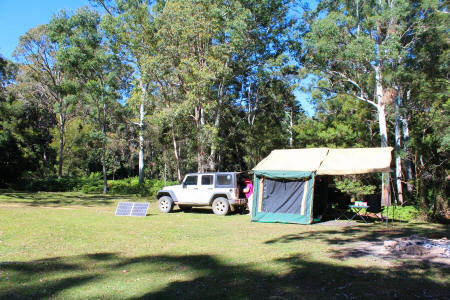 |
|
suitable size solar panel & battery setup for long
stays when bush camping |
How long will a 12 volt compressor fridge run on
a 12 volt battery when
camping is a very common question, however it does not have a simple
answer. It is a bit more involved than buying a fridge & plugging it
into a battery. This article is not meant to be too technical, but a
little theory is needed to explain how things work & how to select
the right battery size to suit your needs without blowing your
budget.
a little theory
Apart
from Lithium Iron Phosphate batteries (LiFePO4) & the new Lead
Crystal batteries that are now on the market, an
AGM (Absorbed Glass Matt)
deep cycle 12 volt battery
is the best battery type suited
for camping, as it can be discharged more deeply &
accepts
a charge more readily than a cranking battery which is used to start
your vehicle.
The capacity of
an AGM deep cycle battery is stated in amp-hours (Ah).
On each 12 volt accessory there will be a label with
electrical terms & figures. From this you can calculate the power an accessory
will consume from an AGM battery? Listed on the label will be
amperage, (A or amps) at 12 volt. There may also be 24 volt or 240 volt if
the accessory has dual voltage input. If the label only
shows watts & volts you can easily work out amps by dividing the
watts by volts ie 100 watts divided by 12 volts = 8 amps.
Amp hour is the amount of current that flows in one hour. To work
out the amp hours that will be consumed by an accessory from an AGM
battery, you simply multiply the amp draw by the
number of hours the accessory is running. As an example the
accessory has 8 amps draw x 4 hours running time = 32 amp hours used.
You run a LED light under
the awning of your camper trailer & it draws 2 amps.
*
over 1 HOUR the light will draw 2 AMP HOURS from your AGM battery,
* 1 AMP HOURS in HALF AN HOUR
* 0.5 AMP HOURS in a QUARTER OF AN HOUR
* if the light ran for 4 HOURS it would consume 8 AMP HOURS, that is 2 amps x 4 hours =
8 amp hours.
Let's say you run a 12 volt electric blanket for 2 hours before you
jump into bed on a cold winters night so the sheets are nice & warm. The
blanket draws 4 amps, therefore it will use 8 amp hours. That is 4
amps x 2 hours = 8 amp hours.
You set up a 12 volt water pump for showering which has a draw of 8
amps. When bush showering to save your limited water supply, you
use the shower to wet down, turn it off & then back on to wash the
soap off. All up the pump will be running for around 2 minutes per
shower. In these circumstances the pump would use 0.25 amp hours per
shower. If there were four people showering, the pump would use 1
amp hour.
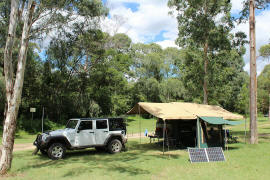 |
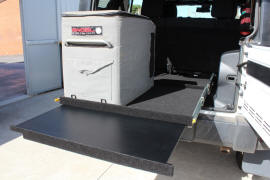 |
| fridge
in awning shade on a hot day |
40
litre Engel fridge in rear of our vehicle |
12 volt
compressor fridge
A compressor fridge/freezing may have a draw of
2.5 amps at 12 volt on the label as an example, however it does not run
continually, but cycles
or turns on & off to maintain the internal temperature you have
set. There
are a number of factors that will govern how often the fridge will
run to keep the preset internal temperature. These include -
* size of the fridge
* internal preset temperature
* ambient temperature
* how full the fridge is
* the number of times the fridge is opened
* the number of items at ambient temperature that are placed in the fridge
* the fridges position such as inside a hot vehicle.
So how do you work out what amp hours the fridge really draws over a
twenty-four hour period. There are a number of meters around which
you can plug into the power lead between the fridge & battery.
The meter not only shows instant readouts, but also counts the amp
hours used, which is a very handy tool to leave connected over twenty-four
hours to give you the daily amp hours a fridge has used.
I have a Watts Up Meter
http://www.campertrailers.org/watts_up_meter.htm which I have
built onto a jiffy box so it can plug into different 12 volt accessories with
cigarette lighter fittings. It can also be used between the solar
panel & battery which uses Anderson connectors, so I can see
what the panel produces over a day.
If the fridge drew 2.5 amps & did run continuously, it would
consume 60 amp hours over a twenty-four hour period.
Here are the actual amp hour figures of our 40 litre Engel run as a
fridge in the back of our vehicle when camping over a twenty-four
period in three different ambient temperature ranges. As you can see
the hotter the day, the more the fridge runs or cycles to keep
the same preset internal temperature.
|
40 litre Engel actual
power draw when camping |
|
fridge dial |
fridge internal temp |
ambient min temp |
ambient max temp |
amp draw |
amp hours over 24 hours |
average amp draw |
run time |
| 1.3 |
2.5
celcius |
10
celcius |
20
celcius |
2.5 |
10 |
0.4 |
one-sixth |
| 1.3 |
2.5
celcius |
20
celcius |
30
celcius |
2.5 |
20 |
0.83 |
one-third |
| 1.3 |
2.5
celcius |
30
celcius |
40
celcius |
2.5 |
40 |
1.6 |
two-thirds |
This is a test I did in the garage at home running the 40 litre
Engel as a fridge & then on another day as a freezer after letting
it settle at the freezer temperature
http://www.campertrailers.org/fridge_draw.htm
getting the best
out of your fridge
By sticking to a few guidelines your fridge should work at
the optimum
performance when out camping.
* A cover protects the fridge & gives some insulation, helping to
keep your fridge cool & reducing the power consumption.
* Cool the fridge & its contents before leaving home.
* When packing your vehicle make sure the fridge motor vents are
given space to allow ventilation for best performance.
* Use the correct cable size from the 12volt battery for the amp
draw of the fridge & cable length.
* Keep your fridge cool by taking it out of the vehicle on a hot day
& placing it in the shade under the camper trailer awning.
* Limit the number of times the fridge is opened. This can be hard
with kids.
* Ice bricks or Techi Ice sheets placed inside the fridge will
add to thermal insulation & reduce the power consumption.
* Keeping the fridge full rather than part empty will reduce the
power consumption.
* Vacuum seal your meat & run as a fridge rather than a freezer will
reduce the power consumption.
* Clean the inside after a trip with hot soapy water. We then wipe
the inside with diluted vanilla essence.
* It is recommended that you run the fridge at regular intervals if
its being stored for a period of time.
* Leaving the lid slightly open will reduce mould if not using the
fridge.
a little battery
theory
An AGM or absorbed glass matt
deep cycle battery
is the best 12 volt battery type suited
for camping as it can be discharged more deeply & accepts a charge
more readily than a starter battery. As you can see on the graph below, continually discharging only
10% of the battery capacity may give you 5000 cycles, compared to
continually discharging it to 90% which may give you only 400 cycles. It is
better to have a large deep cycle battery discharged by a small
percentage than a small battery discharging deeply.
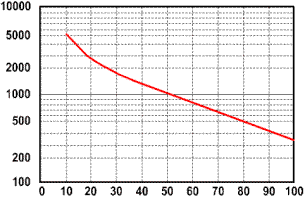 |
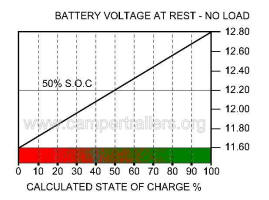 |
| depth of discharge v's
number times recharge |
percentage
of voltage at
rest |
Checking the state of charge of a deep cycle battery
while it is charging using a voltmeter will only show the surface
charge. When discharging a deep cycle battery the voltage will
be below its true state of charge. You need to allow the battery to
'rest' for at least a couple of hours, preferably eight, for the
surface charge to dissipate. It is like filling a glass with Coke &
looking as if it is full, when in fact the top is froth. You need to
let the fizz settle to see how much is really in the glass. The
state of charge does not measure the storage capacity, performance
level or the health of a battery. The best time to check your
battery with a voltmeter is first thing in the morning before you
open the fridge & before you place the solar panel in the sun.
A battery monitor measures the amp hours in & out of a full
battery via a shunt & is the most accurate way to gain the true
state of charge. There are a number of different brands & types of
battery monitors on the market. I installed an Everdrive Elite
battery monitor on our camper trailer's AGM batteries
http://www.campertrailers.org/enerdrive_elite.htm
battery
size
A basic 12 volt battery system can
be as simple as a portable AGM battery in a plastic battery box to cover your
12 volt compressor fridge's power needs over a
weekend & a multi-stage 240 volt battery charger around 10% to 15%
of the battery capacity to maintain the battery at home between
trips. From there you can add a portable solar panel to top up the
battery during the day when camping & later perhaps a DC to DC charger to fully
charge the battery from the vehicles alternator when driving between
campsites on a touring holiday.
When setting up a 12 volt system to suit your needs always look at
the bigger picture as a whole or what your ultimate battery setup will be.
This will save you money in the long run as you can buy the correct
size chargers & cable right from the start.
Lets say if your compressor fridge
is run as a fridge & uses 20 amp hours over a 24 hour period.
Over a two day weekend the fridge would use 40 amp hours. Therefore a
100 amp hour AGM battery would be suitable, keeping in mind
not to discharge your deep cycle battery below
50% capacity.
If you are camping over four days, the fridge
would consume 80 amp hours, so you need 160 amp hours of battery in
total. One 150 amp hour battery is heavy & takes up a lot of space,
so two 100 amp hour batteries would be a suitable choice installed
in the camper trailer also spreading the weight. Even if you do have
a solar panel, you cannot rely on the sun being out & you are
more than likely to be running other accessories.
solar panel size
What size solar panel do you need to fully charge your battery? This depends on the season, your location & the available
Peak Solar Sun Hours. Again it is not just a simple process of
saying A+B=C.
Peak Solar Sun Hours is the number of hours when
solar irradiance averages 1000 watts per square meter, however with
a portable solar panel you can pick up more solar by pointing the
panel to face the sun during the day. It is a good idea to choose your solar panel size so
the battery is fully charged by after lunch.
You also need to take into account the output loss caused by temperature
of the solar panel & cable voltage drop which can result in the
panel only producing 70% of its rated output. Printed on the rear of
a solar panel there will be two output figures, one at 25 degrees celcius
& the other at say 47 degrees celcius. These are the actual temperatures of the
panel itself & not air or ambient temperature. Typically there is 5%
output loss for every 10 degrees celcius the panel is above 25
degrees celcius.
putting it all
together
Richard's Solar Spreadsheet is an
easy way to work out the battery & solar panel size you require
by calculating the power usage of various 12 volt accessories
http://www.campertrailers.org/solar_spreadsheet.htm
On the info page you
will find a table for Peak Solar Sun Hours
showing
selected locations & months. In Sydney for example around
the spring & autumn equinoxes when there is twelve hours daylight &
twelve hours night, there are only 5.6 Peak Solar Sun Hours, if you
have a fixed solar panel facing north.
In your calculations you can throw
into the spreadsheet an overcast day with
little or no solar input & see how the battery recovers via the
solar panel. This
can be important if you are setting up a remote camp for a period of
time & relying only on solar to maintain your battery that is
running everything.
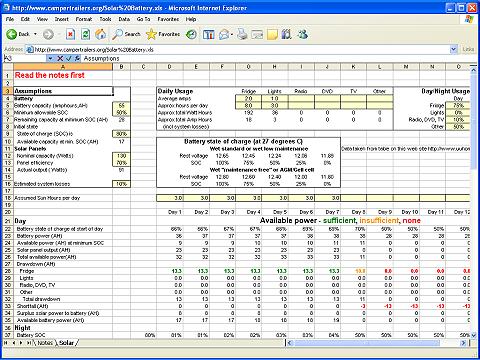
solar regulators
A solar panel produces around 18 volts or more so this needs to be
reduced as not to overcharge & damage the battery. This is done by
connecting a solar regulator between the panel & the battery. A
solar regulator can be mounted on the back of the panel or next to
the battery that is being charged. There
are two different types of solar regulators, PWM & MPPT.
PWM or Pulse Width Modulation slowly lowers the amount of power
applied to the battery as the battery gets closer to fully charged. This allows the battery to be more fully charged
with less stress, extending the battery life.
MPPT or Maximum Power Point Tracking regulators are able to convert
excess voltage into amperage by calculating the output from solar
panels to provide the maximum current possible at the required
voltage at any given point. During low light level situations the
MPPT will compensate for the low light level & find the new point at
which the solar cell delivers its maximum power output.
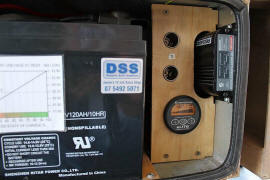 |
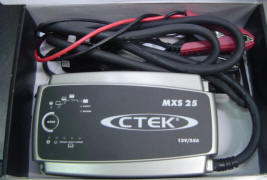 |
| Redarc BCDC1225 charger &
Enerdrive battery monitor |
Ctek 240 volt 25 amp
battery charger for home charging |
chargers
After running the fridge from a
suitably sized
deep cycle battery over the weekend & keeping the battery capacity above
50%, you will need to charge
the battery at home to maintain it in a state of good health. A rule
of thumb for sizing a 240 volt multistage charger is around 10% to 15% of the battery capacity, that
is a 10 amp to 15 amp charger is suitable to charge a 100 amp hour
deep cycle battery. If you are looking at adding another battery
sometime in the future, you will save money by buying a charger to
suit your intended battery capacity from the start.
There
could also be times when you are on a touring holiday & run into
some bad weather needing
to drop into a caravan park to connect the 240 volt charger to
your camper trailer batteries. A smaller charger will do the job, but the
recommended 10% to 15% capacity will charge the battery overnight so
you can continue your holiday with a fully charged battery.
What does multistage mean? The charger will go
through three or more
stages to fully charge the 12volt AGM battery. The most common
multistage charger has three stages to give the battery a more
complete charge.
Stage one is also know as boost mode & charges the battery at a
constant amperage until the battery voltage reaches around three
quarters capacity.
Stage two is also known as absorption. This mode maintains the
elevated voltage from the bulk phase, but adjusts the amperage
accordingly. As the battery charge level approaches capacity, the
current approaches zero. Absorption voltage output depends on the
battery type, for example an AGM/Gel is 14.5 volts, standard lead
acid 14.9 volts & a calcium battery 15.3 volts.
Stage three is also known as float. After the battery is fully
charged the voltage is reduced to a lower level to reduce gassing
and prolong battery life. This is sometimes referred to as a
maintenance or trickle charge. Float voltage for an AGM/Gel,
standard lead acid & calcium battery are all the same at 13.3 volts,
the main purpose of which is to keep an already charged battery from
discharging.
The same 10% to 15% rule of thumb applies when
selecting a DC
to DC charger which are also a multistage battery charger & charges
the 12volt AGM battery in the camper trailer from the vehicles
alternator when driving. Some DC to DC chargers also incorporate an inbuilt MTTP solar regulator. This means
non-regulated output from the solar panel is connected straight to
the charger which is installed next to the battery it is charging.
Most commercial folding portable solar panels will already have a
solar regulator on the back, however this can be kept on the panel &
easily bypassed. The regulator on the back of the panel may come in
handy one day to charge your vehicles battery or perhaps someone
else's battery.
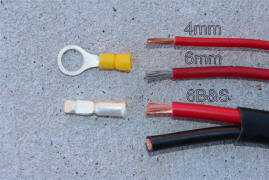 |
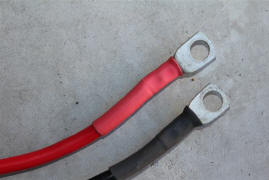 |
| cable sizes |
cable terminals crimped &
heat shrink sleeving |
cable size
Cable size is an important aspect of any 12 volt system. Undersize
wiring is the most common problem as to why a fridge or any other
accessory for that matter, does not work as it should. Undersize
wiring causes heat & therefore voltage drop, which in turn is like
running the fridge on a flat battery in extreme cases. Collyn Rivers recommends
a 3% voltage drop is the
acceptable maximum for runs from the battery to a 12 volt accessory.
12 volt wire size can be very confusing as there are several
wiring codes being used in the industry such as AWG, ISO, auto
cable, B&S & square mm. To make it more confusing, auto
wire measures the outer diameter of the insulation itself,
having no reference to the actual copper conductor size.
The Solar Wind online calculator is an easy way to work out what
size cable to use by placing the amp draw of the accessory & cable
length in the windows
http://www.solar-wind.co.uk/cable-sizing-DC-cables.html Solar
Wind has given campertrailers.org permission to reproduce
the cable size calculator found on their website.
The square mm result can be converted to the nearest
B&S or auto cable size by using the table below. Campertrailers.org has permission from Collyn Rivers to reproduce
his cable conversion table which gives a handy reference converting
between the various cable sizes. Cable suited for 12volt work around
the camper trailer under 6 square mm is usually referred to in auto
cable size, while over 6 square mm is B&S. Twin core sheathed cable
is used where the cable could be exposed to chaffing, giving it more
protection. If the cable is exposed to the harsh environment on the
outside of the vehicle or camper trailers it can be encased in
plastic corrugated split tubing.
cable conversion
table
|
Sq.mm - ISO |
0.75 |
1.0 |
1.5 |
2.5 |
4.0 |
6.0 |
10 |
16 |
25 |
35 |
50 |
70 |
95 |
120 |
150 |
|
Auto
Cable |
2.5 |
3.0 |
4.0 |
5.0 |
6.0 |
|
8.0 |
|
|
|
|
|
|
|
5/0 |
|
AWG |
18 |
17 |
15 |
14 |
12 |
10 |
8 |
6 |
4 |
2 |
1 |
2/0 |
3/0 |
4/0 |
5/0 |
|
B&S |
18 |
17
|
15 |
14 |
12 |
10 |
8 |
6 |
3 |
2 |
0 |
2/0 |
3/0 |
4/0 |
|
Note: this table is copyright ‘Solar That Really Works' third
edition, 2012
Caravan
and Motorhome Books by Collyn Rivers
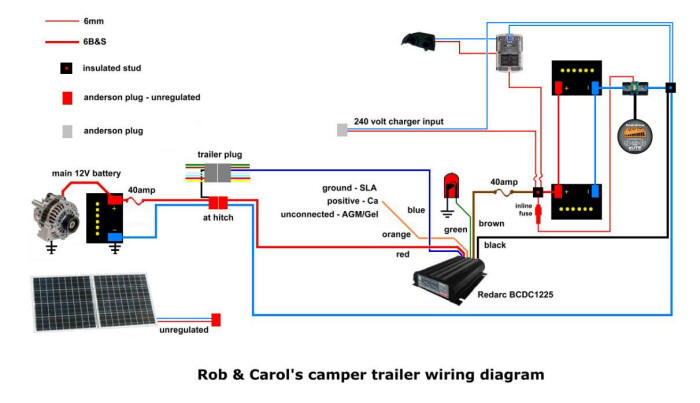 |
| our 12 volt battery
wiring diagram |
our setup
On our camping trips we tend to roam, exploring
as we travel from one bush campsite to the next, mostly staying only
a day or three at each location
http://www.campertrailers.org/newcastle_to_brisbane_backroads.htm
The longest period we camp in the one spot is six days over Easter &
ten days during the Australian CamperTrailers Group national meets,
while the longest duration wandering has been over four months. We
have no trouble keeping the batteries fully charged thanks to the Redarc BCDC1225 DC to DC charger. There is no need to visit a
powered site at a caravan park.
The two 120 amp hour Ritar AGM deep cycle
batteries are housed in a box each side of the camper trailer &
wired in parallel, that is positive to positive & negative to
negative, making them one big battery of 240 amp hours at 12 volt.
The positive of the chargers are wired to the positive terminal on
one battery while the negative of the chargers are wired to the
negative terminal on the opposite battery. The same method is used
with wires from the both battery terminals going to the fuse block. Connecting,
charging & discharging batteries in this manner has proved very
successful for battery longtivity as the batteries are now eight years old & show 12.8
volts at
rest.
While at home the batteries are maintained using a 25 amp 240 volt
multistage battery charger which is portable as there is no room in
the battery boxes. The battery chargers charging outlet has an Anderson
connector so it can be easily connected to the two camper trailer batteries when needed.
I can also use the charger on the vehicles starter or auxiliary
battery.
Between campsites the 25 amp output of the Redarc
BCDC1225 3-stage charger
sees the batteries fully charged in most circumstances from the
vehicles alternator while we drive during the day. When camped the batteries
are charged via the MPPT solar regulator inbuilt into the Redarc BCDC1225
from the unregulated output of two 65 watt Kyocera
folding panels. This is the Redarc install
http://www.campertrailers.org/bcdc1225_install.htm
The Plasmatronics PL1210 solar regulator was left in place on the
back of the solar panels & bypassed to allow unregulated output to
the Redarc BCDC1225 MPPT solar regulator. The solar panels can be used
to charge our vehicles starter battery if needed via the
Plasmatronics regulator. The two Anderson connectors on the solar
panel are simple to
use, unregulated output
is red, while the grey Anderson has regulated output. Different
coloured Anderson connectors cannot be joined together, however to keep
it simple I have doctored the red Anderson. Alternately you could
paint the unregulated Anderson with red nail polish or label it.
There is very little voltage drop from a ten metre length of 6mm
twin core sheathed auto cable running from the solar panel to the MPPT
regulator in the Redarc BCDC1225 next to the batteries. We have
found it is a good length to chase the sun around the shadows of
trees during the day.
An Enerdrive
battery monitor is used to give us a accurate indication of the
batteries state of charge. It does require periodical synchronizing
so the monitor displays the correct figures
http://www.campertrailers.org/enerdrive_elite.htm
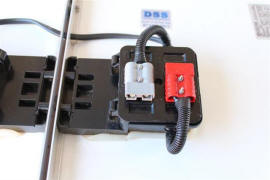 |
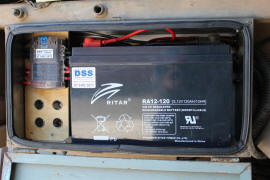 |
| red
unregulated & grey regulated anderson
connectors |
six
blade fuse block & cigarette socket outlets |
We have an average daily power consumption of around 40 amp hours
over a twenty-four hour period depending on the season for the
fridge power draw. On most days in camp the batteries are fully charged by
after lunch thanks to the Redarc BCDC1225 MPPT solar regulator. The
average battery draw broken down is.....
* 20 amp hours average for the 40 litre Engel fridge running as a
fridge
* 10 amp hours for the 12 volt Cpap machine running for 8 hours
* perhaps 10 amp hours average depending on what we are charging
including.....
* laptop via the laptop 12 volt power supply
http://www.campertrailers.org/laptop_power_supply.htm
* Canon camera batteries via a 12volt battery charger
* iphone & ipad via a USB port cigarette socket adaptor
* 12 volt charger for rechargeable AAA batteries used in hand held
torches & head torches
* hand held UHF 12 volt battery charger
We have 12 volt chargers for all accessories as we did not want to
go down the 240 volt inverter road. That may have been different if
the Cpap was a 240 volt model.
It can get complicated with the different 12 volt chargers & leads,
but everything is labelled to avoid confusion. Bar clamps
are useful to stop leads from tangling too.
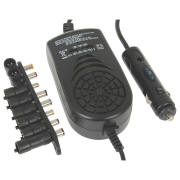 |
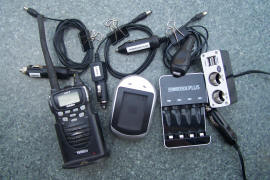 |
| laptop
12 volt power supply |
12volt
chargers for UHF, Canon Camera battery, AA/AAA batteries & USB adaptors for iPhone & iPad |
further reading
Bill Darden battery facts
http://www.batteryfaq.org
Collyn Rivers articles
https://caravanandmotorhomebooks.com
Smart Gauge
http://www.smartgauge.co.uk/technical1.html
wiring diagrams
http://www.campertrailers.org/jamies_12volt_wiring_diagrams.htm
voltage drop calculator
http://www.solar-wind.co.uk/cable-sizing-DC-cables.html
Collyn Rivers page
http://www.campertrailers.org/collyns_page.htm
Redarc BCDC1225 install
http://www.campertrailers.org/bcdc1225_install.htm
Redarc BCDC1225 feedback
http://www.campertrailers.org/bcdc1225_feedback.htm
Enerdrive battery monitor install
http://www.campertrailers.org/enerdrive_elite.htm
Watts Up meter
http://www.campertrailers.org/watts_up_meter.htm
35 litre Engel fridge draw
http://www.campertrailers.org/fridge_power_consumption.htm
info by Rob
january
2018 |